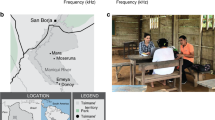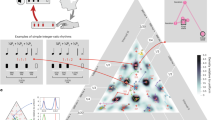Abstract
We examined the influence of incidental exposure to varied metrical patterns from different musical cultures on the perception of complex metrical structures from an unfamiliar musical culture. Adults who were familiar with Western music only (i.e., simple meters) and those who also had limited familiarity with non-Western music were tested on their perception of metrical organization in unfamiliar (Turkish) music with simple and complex meters. Adults who were familiar with Western music detected meter-violating changes in Turkish music with simple meter but not in Turkish music with complex meter. Adults with some exposure to non-Western music that was unmetered or metrically complex detected meter-violating changes in Turkish music with both simple and complex meters, but they performed better on patterns with a simple meter. The implication is that familiarity with varied metrical structures, including those with a non-isochronous tactus, enhances sensitivity to the metrical organization of unfamiliar music.


Similar content being viewed by others
References
Bartók, B. (1976). Turkish folk music from Asia Minor. Princeton: Princeton University Press.
Bialystok, E., Craik, F. I. M., & Luk, G. (2008). Cognitive control and lexical access in younger and older bilinguals. Journal of Experimental Psychology: Learning, Memory, and Cognition, 34, 859–873.
Bialystok, E., & DePape, A.-M. (2009). Musical expertise, bilingualism, and cognitive functioning. Journal of Experimental Psychology: Human Perception and Performance, 35, 565–574.
Clarke, E. F. (1999). Rhythm and timing in music. In D. Deutsch (Ed.), The psychology of music (2nd ed., pp. 473–500). New York: Academic Press.
Clayton, M. (2000). Time in Indian music. New York: Oxford University Press.
Cutler, A., Mehler, J., Norris, D., & Seguí, J. (1986). The syllable’s differing role in the segmentation of French and English. Journal of Memory and Language, 25, 385–400.
Demorest, S. M., Morrison, S. J., Beken, M. N., & Jungbluth, D. (2008). Lost in translation: an enculturation effect in music memory performance. Music Perception, 25, 213–223.
Drake, C., & El Heni, J. B. (2003). Synchronizing with music: intercultural differences. Annals of the New York Academy of Science, 999, 429–437.
Drake, C., Jones, M. R., & Baruch, C. (2000). The development of rhythmic attending in auditory sequences: attunement, referent period, focal attending. Cognition, 77, 251–288.
Flege, J. (2002). Interactions between the native and second-language phonetic systems. In P. Burmeister, T. Piske, & A. Rohde (Eds.), An integrated view of language development: papers in honor of Henning Wode (pp. 217–244). Trier: Wissenschaftlicher Verlag.
Gosvami, O. (1961). The story of Indian music: its growth and synthesis. Bombay: Asian Publishing.
Hannon, E. E., & Johnson, S. P. (2005). Infants use meter to categorize rhythms and melodies: implications for musical structure learning. Cognitive Psychology, 50, 354–377.
Hannon, E. E., & Trehub, S. E. (2005a). Metrical categories in infancy and adulthood. Psychological Science, 16, 48–55.
Hannon, E. E., & Trehub, S. E. (2005b). Tuning in to musical rhythms: infants learn more readily than adults. Proceedings of the National Academy of Sciences USA, 102, 12639–12643.
Jairazbhoy, J. A. (1995). The rags of North Indian music: their structure and evolution. Bombay: Popular Press.
Kaushanskaya, M., & Marian, V. (2009). The bilingual advantage in novel word learning. Psychonomic Bulletin & Review, 16, 705–710.
Kim, J., Davis, C., & Cutler, A. (2008). Perceptual tests of rhythmic similarity: II. Syllable rhythm. Language and Speech, 51, 343–359.
London, J. (2004). Hearing in time. New York: Oxford University Press.
MacLeod, C. M. (1991). Half a century of research on the Stroop effect: an integrative review. Psychological Bulletin, 109, 163–203.
Montfort, M. (1985). Ancient traditions—future possibilities: rhythmic training through the traditions of Africa, Bali and India. Mill Valley: Panoramic Press.
Phillips-Silver, J., & Trainor, L. J. (2005). Feeling the beat: movement influences infant rhythm perception. Science, 308, 1430.
Phillips-Silver, J., & Trainor, L. J. (2007). Hearing what the body feels: auditory encoding of rhythmic movement. Cognition, 105, 533–546.
Sambamurthy, P. (1968). A practical course in Karnatik music. Madras: Indian Music Publishing House.
Sanz, C. (2000). Bilingual education enhances third language acquisition: evidence from Catalonia. Applied Psycholinguistics, 21, 23–44.
Strait, D. L., Kraus, N., Parbery-Clark, A., & Ashley, R. (2010). Musical experience shapes top–down auditory mechanisms: evidence from masking and auditory attention performance. Hearing Research, 261, 19–22.
Su, Y.-H., & Pöppel, E. (2011). Body movement enhances the extraction of temporal structures in auditory sequences. Psychological Research,. doi:10.1007/s00426-011-0346-3.
Wong, P. C. M., Roy, A. K., & Margulis, E. H. (2009). Bimusicalism: the implicit dual enculturation of cognitive and affective systems. Music Perception, 27, 81–88.
Acknowledgments
Funding for this research was provided by the Natural Sciences and Engineering Research Council of Canada. We thank Jon Prince for his contribution to stimulus preparation.
Author information
Authors and Affiliations
Corresponding author
Electronic supplementary material
Below is the link to the electronic supplementary material.
Rights and permissions
About this article
Cite this article
Kalender, B., Trehub, S.E. & Schellenberg, E.G. Cross-cultural differences in meter perception. Psychological Research 77, 196–203 (2013). https://doi.org/10.1007/s00426-012-0427-y
Received:
Accepted:
Published:
Issue Date:
DOI: https://doi.org/10.1007/s00426-012-0427-y




